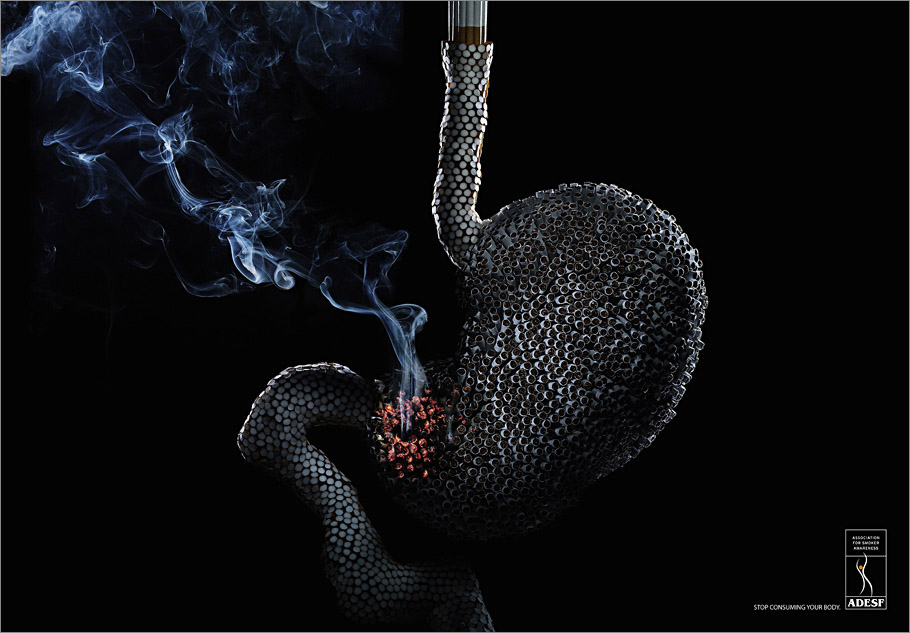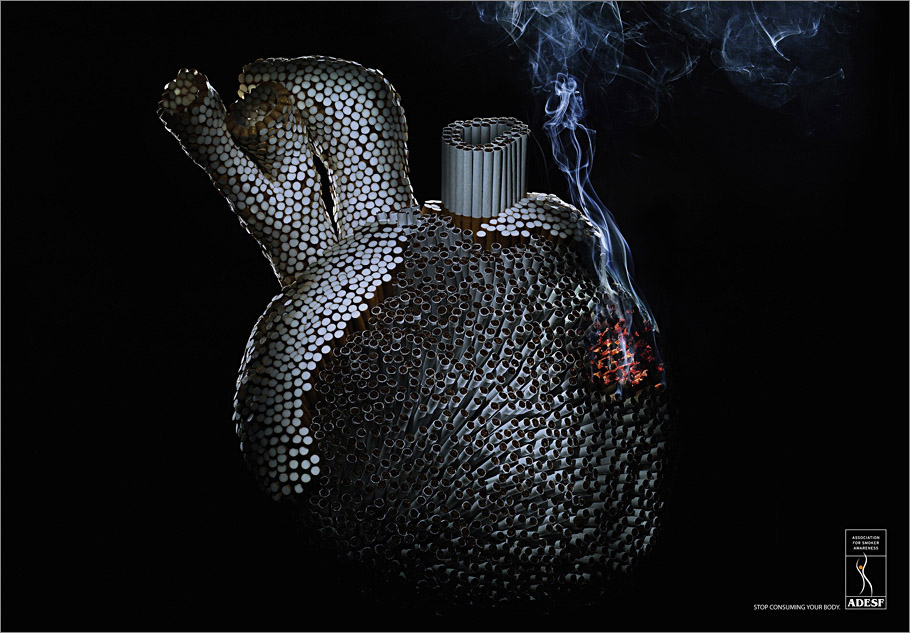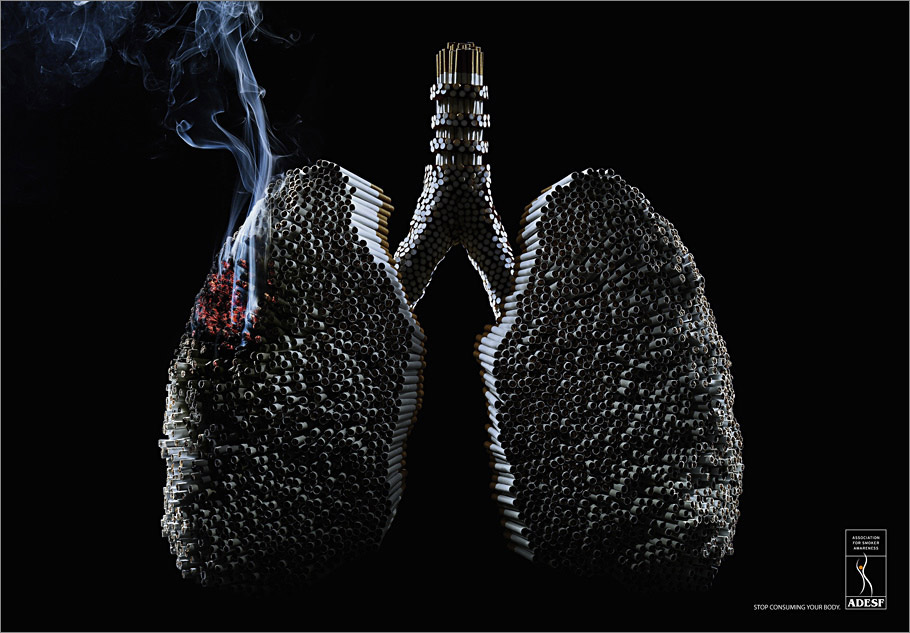An unofficial blog about the National Museum of Health and Medicine (nee the Army Medical Museum) in Silver Spring, MD. Visit for news about the museum, new projects, musing on the history of medicine and neat pictures.
Thursday, July 10, 2008
A Flickr / Getty Images deal in the works?
Wednesday, July 9, 2008
Do Not Smoke
Stop Consuming Your Body
“Stop Consuming Your Body”
Advertising Agency: NeogamaBBH, Brazil
Art Director: Sidney Araújo
Copywriter: Alexandre Gama
Leprosy Stigma
Afternoon Coffee Talk at the NMHM
What: Lecture, "Carville, the Landscape of Stigma," by Elizabeth Schexnyder, Curator, The National Hansen's Disease Museum
When: Wednesday, August 27, 2:00 p.m.
Where: Russell Auditorium, National Museum of Health and MedicineLeprosy is known as the "Biblical" disease and has been associated with a stigma that affects the lives of those with leprosy, both physically and socially. Did you know that at one time Coca Cola refused to pick up empty Coke bottles from the National Leprosarium in Carville, Louisiana for fear that contact with the bottles might spread the disease? Join Elizabeth Schexnyder, curator of the National Hansen's Disease Museum, for a discussion of the meaning and significance of the social response to leprosy in the development of the National Leprosarium in Carville, Louisiana. She will describe how the process of "othering" human beings diagnosed with leprosy along with the socio-historical factors affecting the disease stigma shaped the unique landscape--both social and physical--of the National Leprosarium.
Tuesday, July 8, 2008
Jim Cassedy lecture at National Library of Medicine
NATIONAL LIBRARY OF MEDICINE,
History of Medicine Division Seminar - First Annual James Cassedy
Memorial Lecture Tuesday, July 15, 2008, 2-3:30pm (Note Revised Date)
Lister Hill Center Auditorium, Bldg 38A, NLM Bethesda, MD
"Medicine by the Numbers: Revisiting James Cassedy's America."
Robert Martensen, MD, PhD
Director, Office of NIH History
To honor the distinguished historian of medicine and long-time National Library of Medicine staffer Jim Cassedy, the History of Medicine Division at NLM is sponsoring the first annual James Cassedy Memorial Lecture. The first speaker will be Robert Martensen, MD, PhD, who will speak on "Medicine by the Numbers: Revisiting James Cassedy's America."
During his long career, Cassedy repeatedly explored the rich history of counting and calculating that preoccupied many mid-19th century American physicians. While numerical inquiries had long interested social historians and demographers, Cassedy's American Medicine and Statistical Thinking, 1800-1860 (1984) and Medicine and American Growth, 1800-1860 (1986) stimulated intellectual historians to analyze how and why our medical forbears embraced statistics. In this talk, Martensen re-visits
Cassedy's mid-century accounts and explores how physicians re-defined medical arithmetic as medicine turned increasingly to laboratory science in the century's closing decades.
All are Welcome
Note: The next history of medicine seminar will be on Thursday, July 24, 2-3:30pm in the Lister Hill Visitor's Center NLM's Bldg 38A. Doctoral candidate Chin Jou of Princeton University will speak on "Prescribing Bodies: Medical Critiques of Fat and Thin, 1890-1930."
Sunday, July 6, 2008
Cool article on London's archeological skeletons
Museum of London's skeleton key to the bodies under city's streets
Tens of thousands of skeletons that lie hidden beneath the streets, houses and offices of London have been revealed for the first time on a map, in a collaboration between the Museum of London and The Times.
Monday, June 30, 2008
When robots operate
The invasion of the surgeon robots. - By Kent Sepkowitz - Slate Magazine: "There is one realm, however, in which robots really are joining the gang: the operating room. It turns out that Americans love to be operated upon by them. Last year, robots participated in thousands of surgeries, and the years ahead promise even more choices. Cancer surgery, heart surgery, brain surgery, you name it—R2-D2 awaits your call. The robots even have their own medical journal (OK, it's run by the humans who operate the robots, but egad!)."
Friday, June 27, 2008
Eakins' The Gross Clinic

The Philadelphia Museum of Art will bring back The Gross Clinic this summer. According to the latest newsletter, it is "described by some as the most important painting by any nineteenth-century American artist." It will be exhibited in gallery 119 from August 2 until February 2009. Read more about the painting itself, including how it was nearly lost to Philadelphia, at wikipedia.
Thursday, June 26, 2008
Acupuncture


Here's a mannequin from the History of Medicine Museum in Paris that I think is pretty neat. If I read the French correctly, the label says it shows acupuncture points. The other picture is a close-up of some cards that are in the case with the mannequin.
For those of you without personal acupuncture experience and perhaps doubt that it really can work, let me tell you it does. My husband always said he'd quit smoking when cigarettes hit $1 a pack. Of course, this was a very long time ago, and also of course, easier said than done. But he heard about a doctor in Austin or Houston, I don't remember now, who performed acupuncture and for $50 decided to give the guy a try. The doctor put one little staple-looking thing in Bob's ear, in that ridge of cartilage, put a piece of tape over it, and told him to leave it until it fell out. About a week later it did, but from the time the staple went in, Bob never smoked again. He said the cravings came and went in a flash, more quickly than he even had time to think about them, and gradually faded away. Amazing, isn't it? I'm a believer.
Rhode hasn't been here cracking the whip


and so postings to this blog have gotten pretty slack. But he's back now and trying to make us all feel guilty. It's working.
Well, as I promised, or warned, depending how you want to look at it, here are a couple of pictures of kidney stone removal tools. (I wish they were a little sharper, but you do what you can with what you have. In this case, the camera was hand-held.) If these don't make you get your 128 ounces of water every day, I don't know what will.
Wednesday, June 18, 2008
Flickr - we are not alone
Tuesday, June 17, 2008
Wow. Wow. Wow.
Human egg makes accidental debut on camera: "Look closely: this is history in the making. These are the clearest pictures ever taken of what is the starting point of every human life: ovulation occurring inside a woman's body."
Human ovulation captured on film: "Following the publication last week of the best ever photos of the ovulation of a human egg, we now go, Fantastic Voyage-like, to the first video footage of the moment itself."
Thanks to New Scientist for bringing this to us.
Mememto Mori, or, The Head of Janus


I made a rewarding visit to the Musée d'Histoire de la Médecine in Paris last month, but thoroughly grossing out my husband with its extensive exhibits of surgical tools, including kidney stone extractors. Not something that a man who has had a kidney stone especially wants to look at. I've not had kidney stones, and I found the tools and illustrations painful to look at, and I've seen some pretty gross things in the course of my job. Do you want to see them? Next time.
I really liked this ivory carving from the 17th century, called the Head of Janus. I don't know if the Catholic school I went to didn't teach mythology as a matter of theology or what, but I never learned about the myths. So wikipedia to the rescue: "Janus was usually depicted with two heads (not faces) looking in opposite directions, and was frequently used to symbolize change and transitions such as the progression of past to future, of one condition to another, of one vision to another, the growing up of young people, and of one universe to another. He was also known as the figure representing time because he could see into the past with one face and into the future with the other."
There's nothing that says transition from one condition to another like a face on one side and a skull on the other.
Telemedicine, literally
While human interaction is still necessary because self-reporting isn't always reliable, allowing patients to text-message results from their urine tests - and get free minutes as a reward - apparently gets better participation during the six-month regimen.
Companion Animals for Stress Response - program at Walter Reed

This came in via email today, but before you get to it, let me introduce you to a companion animal I met one day at lunch, Georgia the assistance dog ---->:
Her "uncle," the brother of the patient who Georgia assists, let me take several pictures of her while she was out for some exercise. She's a beauty and full of energy. I think it was very hard for her to lie still for 30 seconds.
Now, back to our sponsor:
Dear Friends of CAMP PTSD,
Please join us for our next program, Benefits of Companion Animals for
Stress Response on Thursday June 26, 2008 at 4:30pm - 6pm at the Joel
Auditorium at Walter Reed Army Medical Center.
Our presenters are:
* Kevin Simpson, Director of Animal Behavior and Training at the
Washington Humane Society, and
* Joan Esnayra, Phd, Founder of the Psychiatric Dog Service
Society
Please forward this message to anyone you know who may be interested in
this fascinating program.
To RSVP, contact Elsyse Greenberg at elyse.greenberg@amedd.army.mil
Hope to see you there!
Robin Carnes, Chair
Complementary and Adjunctive Medicine Practitioners PTSD Study Group at
Walter Reed Army Medical Center
(240-423-8544)
CAMP PTSD Study Group
Monday, June 16, 2008
A Day in the Life...
Here's one from a few weeks ago. We're part of the Armed Forces Institute of Pathology (see the sidebar history) and their Radiology Department had a lead on some personal papers they were interested in. The American College of Radiology has stored their records with the History Factory in Chantilly, VA, and in their collection they had personal papers of Dr. William Thompson. Thompson was instrumental in setting up the large radiology program at AFIP. The ACR was willing to hand over this series of records to AFIP since it didn't really relate to their core holdings. I tend to wear a dual hat as AFIP's archivist as well as the Museum's so I was on the job.
Poaching from other archives never thrills me, although at times it makes sense. Years ago, we returned photographs of unidentified corpses that we had received from the NY Medical Examiner to the NY Municipal Archives to reunite them with the paper records of the cases. I was fine with that, but there have been plenty of times when people come in to do research and say "wouldn't this be better if it was in..."
Anyway, two people from the radiology dept., and 3 museum staffers took a van from Walter Reed while I drove myself from home. I beat them by about an hour so I hung around with the archivist there. He showed me the collection - it was pretty straightforward personal papers including diaries, some awards and some photographs, both personal and professional. I've seen dozens like it, and at 3 linear feet, it wasn't large. So we talked shop and then when everyone else arrived, they looked at the records. The radiologists were particularly interested as one doesn't see fifty-year old diaries every day, I suppose. We took a quick look in the stacks at the rest of the ACR collection - most archives look alike especially in the 'bulk' storage areas - and I've got to say that they have a nice set of advertising trade literature if you're doing anything on radiology's history. We also looked at the 3-D artifacts because there was some confusion in our party if we were supposed to be checking on them as well.
After signing the paperwork transferring it to us, we headed back to AFIP. Lauren Clark, who's volunteering as an intern this summer, has processed the collection and written a finding aid to it, which should make it onto our regular website soon. There's nothing deeply interesting or dramatic in Thompson's papers, but they help round out the history of radiology at AFIP.
Two more links for you, if you can handle the excitement
- The iPhone gets all the cool new apps. Sometimes I wish I'd gone into medicine so I could get access to all those wonderful toys.
- Morbid Anatomy - where you can find the awesome with each post - offers a snippet about a cool "20th century facial prosthetic" someone "found at an estate sale." I never find anything like that at estate sales.
Three words: "Belly button escargot"
He had me at "I apologize in advance..."
If you look carefully, you'll see something familiar to this blog's readers and our visitors. Once you spot it, leave your answer in comments. First person (not on the staff or former staff!) to guess correctly gets the best reward of all: my sincere gratitude for reading all the way through this post.
All the good headlines were taken
And yes, I am probably giving away a slice of my blog reading habits by linking to those two blogs above, but for gummi bear anatomy, it's worth it.
Thursday, June 12, 2008
Our West Coast Connection
Enjoy.
Wednesday, June 11, 2008
Upcoming lunchtime lectures this month at NMHM
of Health and Medicine this month!
On Thursday, June 19 at noon, AFIP pathologist Wayne Meyers, M.D. will
discuss the history of leprosy in America.
Then, on Thursday, June 26 at noon, James L. Krahenbuhl, Ph.D., director
of the federal National Hansen's Disease (Leprosy) Program will offer a
talk about the need for a greater awareness about leprosy in the U.S.
Both lectures are free and will take place in Russell Auditorium at
NMHM. After the talks, take advantage of the opportunity to visit our
temporary exhibition, "Triumph at Carville: A Tale of Leprosy in
America."
Here are the details:
What: Lecture by pathologist Wayne M. Meyers, M.D., Ph.D., Armed Forces
Institute of Pathology
When: Thursday, June 19, 2008; 12:00-1:00 p.m.
Where: Russell Auditorium at NMHM (on Walter Reed Army Medical Center,
Building 54)
Cost: Free! Bring a bag lunch.
What: Learn the 113-year history of the "national leprosarium" and the
need for an awareness of leprosy in the U.S. medical community, with
James L. Krahenbuhl, Ph.D., director of the federal National Hansen's
Disease (Leprosy) Program
When: Thursday, June 26, 2008; 12:00-1:00 p.m.
Where: Russell Auditorium at NMHM (on Walter Reed Army Medical Center,
Building 54)
Cost: Free! Bring a bag lunch.
Museum Address: 6900 Georgia Avenue, NW, Building 54, Washington, DC,
20307. (Photo identification required.) Free parking is available.
Contact: (202) 782-2200 or http://www.nmhm.washingtondc.museum


